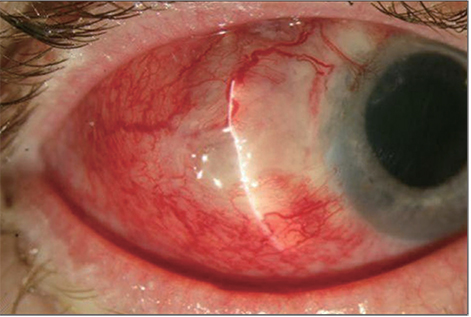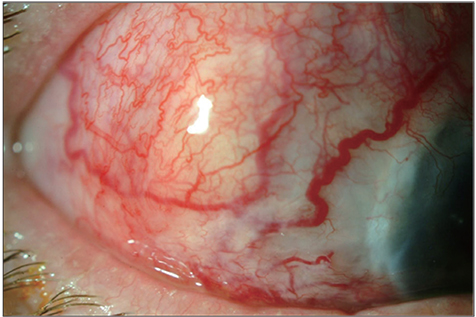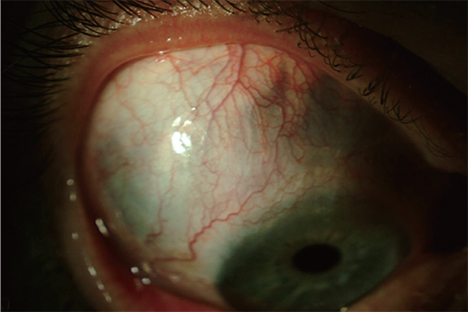Korean J Ophthalmol.
2013 Aug;27(4):291-293. 10.3341/kjo.2013.27.4.291.
Contact Lens-associated Nocardial Necrotizing Scleritis
- Affiliations
-
- 1Southwest Retina Specialists, Amarillo, TX, USA. Ryanbradfordrush21@hotmail.com
- KMID: 1705427
- DOI: http://doi.org/10.3341/kjo.2013.27.4.291
Abstract
- A 52 year-old, contact lens-wearing man presented with progressive right eye pain and redness for one month. He had been evaluated and treated for necrotizing scleritis by multiple eye care specialists prior to presentation. He underwent a complete systemic work-up for both autoimmune and infectious causes of scleritis, including a culture. The culture revealed heavy growth of Nocardia asteroides complexes. The patient was treated with topical amikacin and oral Bactrim. Following several weeks of antibiotic treatment, the patient's infection resolved completely, and his visual acuity returned to baseline status. Nocardia is a rare but potentially devastating cause of necrotizing scleritis that may affect contact lens wearers without an associated keratitis. Prompt recognition and early treatment with appropriate antimicrobial agents are critical to achieve a favorable outcome.
Keyword
MeSH Terms
Figure
Reference
-
1. Albini TA, Rao NA, Smith RE. The diagnosis and management of anterior scleritis. Int Ophthalmol Clin. 2005; 45:191–204.2. Capriotti JA, Pelletier JS, Shah M, et al. Normal ocular flora in healthy eyes from a rural population in Sierra Leone. Int Ophthalmol. 2009; 29:81–84.3. Gordon MA. Aerobic pathogenic Actinomycetaceae. In : Lennette EH, Ballows A, Hassler WJ, Shadomy HG, editors. Manual of clinical microbiology. 4th ed. Washington, DC: American Society for Microbiology;1985. p. 249–262.4. Brooks JG Jr, Mills RA, Coster DJ. Nocardial scleritis. Am J Ophthalmol. 1992; 114:371–372.5. Ramos-Esteban JC, Servat JJ, Silva RS, et al. Necrotizing nocardial scleritis after combined penetrating keratoplasty and phacoemulsification with intraocular lens implantation: a case report and review of the literature. Arq Bras Oftalmol. 2007; 70:355–359.6. Kattan HM, Pflugfelder SC. Nocardia scleritis. Am J Ophthalmol. 1990; 110:446–447.7. Knox CM, Whitcher JP, Cevellos V, et al. Nocardia scleritis. Am J Ophthalmol. 1997; 123:713–714.8. Basti S, Gopinathan U, Gupta S. Nocardial necrotizing scleritis after trauma: successful outcome using cefazolin. Cornea. 1994; 13:274–276.9. Sridhar MS, Gopinathan U, Garg P, et al. Ocular nocardia infections with special emphasis on the cornea. Surv Ophthalmol. 2001; 45:361–378.10. Seth RK, Gaudio PA. Nocardia asteroides necrotizing scleritis associated with subtenon triamcinolone acetonide injection. Ocul Immunol Inflamm. 2008; 16:139–140.11. Choudhry S, Rao SK, Biswas J, Madhavan HN. Necrotizing nocardial scleritis with intraocular extension: a case report. Cornea. 2000; 19:246–248.12. Lee LH, Zaidman GW, Van Horn K. Topical bactrim versus trimethoprim and sulfonamide against nocardia keratitis. Cornea. 2001; 20:179–182.
- Full Text Links
- Actions
-
Cited
- CITED
-
- Close
- Share
- Similar articles
-
- Proper Management for Rigid Gas Permeable Contact and Orthokeratology Lens
- Two Cases of Necrotizing Scleritis After Pars Plana Vitrectomy
- A Case of Enucleation due to Extensive necrotizing Scleritis after Pterygium Excision in a Rheumatoid Arthritis Patient
- Characteristics and Complications of Cosmetic Contact Lens
- Adverse Events of Scleral Contact Lens




